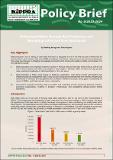| dc.description.abstract | Beef cattle make up 76 per cent of Kenya’s total cattle population, with 87 per cent of them concentrated in
ASALs.2 This underscores the importance of beef production as a livelihood strategy in ASAL counties. Moreover,
the significance of the beef sector in ASALs becomes more apparent when considering the aridity levels within
these regions. The State Department for ASALs and Regional Development acknowledges that climatic conditions
profoundly impact communities, potentially leading to economic vulnerabilities. Counties classified as purely arid,
with 85-100 per cent aridity, rely primarily on mobile pastoralism and account for 47 per cent of beef cattle. Semi-arid counties exhibit a more diversified
economy due to better access to water resources and
infrastructure and account for 24 per cent of beef cattle.
Counties with pockets of aridity (10-29%) hold 16 per
cent of beef cattle, while non-ASAL areas account
for 13 per cent. However, despite the dominance of
livestock production, ASALs continue to exhibit high
poverty rates and socio-economic marginalization.
For example, ASAL counties have an average of 63
per cent multidimensional poverty and 44 per cent
monetary poverty, compared to 52 per cent and 35 per
cent, respectively, for non-ASAL counties.4 This points
to a disconnect between the substantial contributions
of the beef industry and the poverty levels faced by
communities in ASAL counties. | en |

